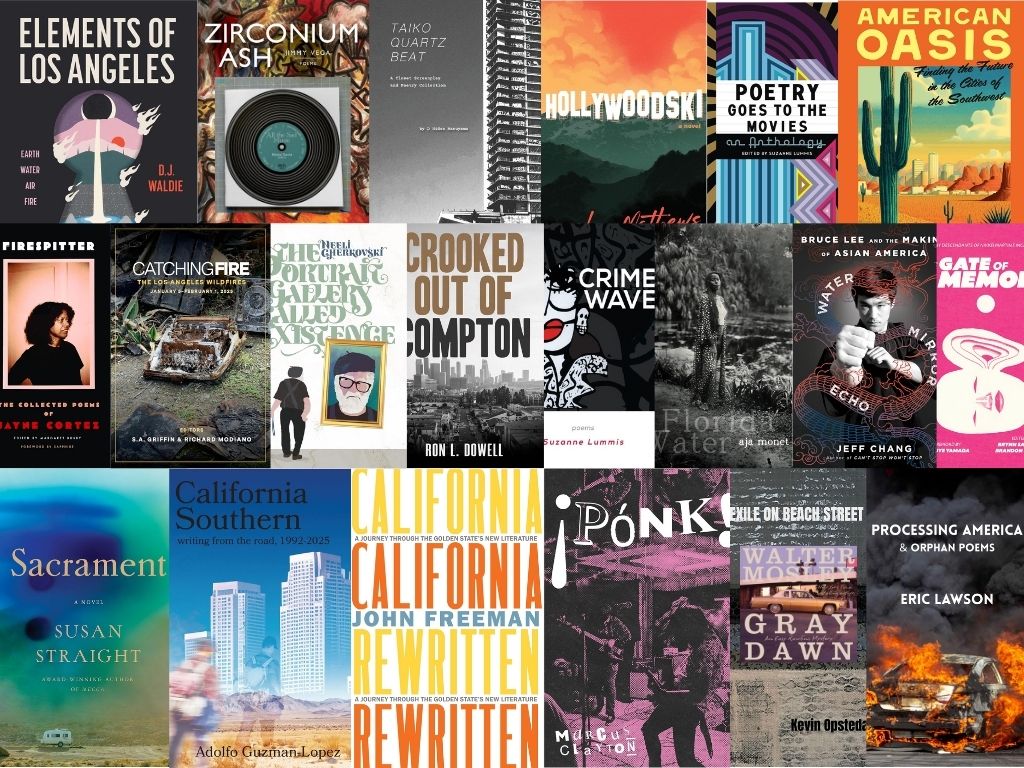Eating a perfect caldo on a hot day is the culinary equivalent of swimming in Scrooge McDuck’s vault.
It’s rich. It’s tender. And it’s all mine, damn it.
Maybe that’s just me. Maybe it’s because when I close my eyes to dream of the perfect soup, I’m always nine years old sitting in a tiny yellow house in Paramount eating caldo de papa while DuckTales makes me forget about the beating I took that day at school. And the caldo’s incredible colors, heat, and flavors gave me the same satisfaction this old cartoon billionaire got from swimming in a sea of gold.
The irony is that broths were traditionally seen as peasant food. Instead of eating six courses on a dais while people yell “The King in The North” or whatever it is rich people do, us hoi polloi took tough proteins like tripe or beef shank and added a cacophony of vegetables and spices all into a pot of water. By slowly cooking the seemingly dissonant ingredients, you’d get something beautiful and bountiful.
Today, caldos are still an affordable way to feed large numbers of people. That’s why birria is served at quinceñeras and bodas instead of prime rib or the chicken plate.
Executed just right, a caldo can feed your family all week long and actually get better the longer it lasts.
More importantly, caldos have restorative powers. They can help heal an upset stomach or treat a cold. They can boost your immune system. Many are considered hangover cures or cures for the common cold. On a winter day, a caldo can warm your spirits. On a hot day, it can help you stay hydrated and balance your body temperature.
And I don’t know about you but at a time when the world is sick and the poor are getting poorer, I’m so down to take a dip in a metaphorical vault full of gold coins. Woo-oo!
So give me a summer of caldos. Of ollas so big they have to be stored in the shed. Pools of elotes and carrots and calabacitas. Piping hot bowls full of edible fortune.
Preferably in the following order ...
The Top 10 Caldos
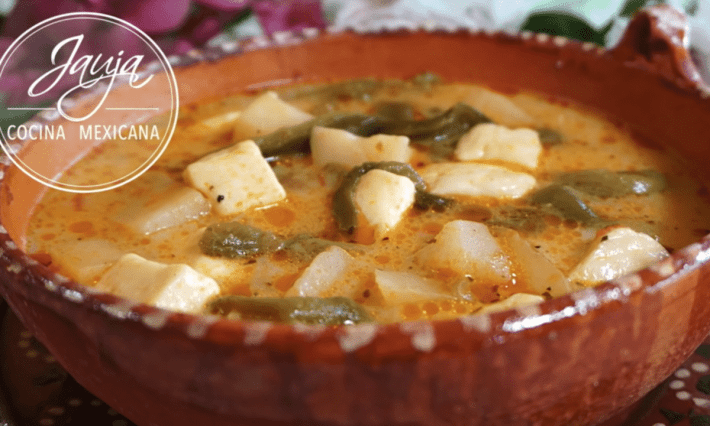
No. 10 Caldo de Papa
This is the first caldo I can remember eating. I grew up poor in Southeast Los Angeles with a decent-sized family. There were five of us kids, my parents, and usually a cousin or aunt from Mexico. An easy and affordable way to feed all these folks a delicious lunch was caldo de papa. It’s a potato broth that appears deceptively simple. It’s just potatoes in chicken stock, right? Wrong. The complicated stock is what really makes this one of the best caldos in la gastronomía Mexicana. Those mom and abuela secrets range from including milk, garlic, tomatoes, peppers, cheese, bouillon powder, bread, and of course, potatoes.
Make it at home: Recipe Video
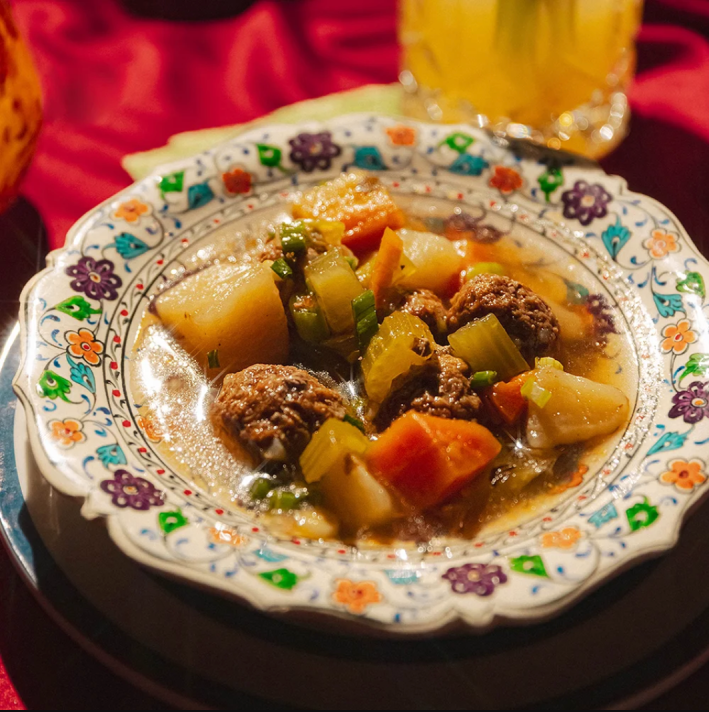
No. 9 Albóndigas
Casa Vega ~ Sherman Oaks
You know it’s going to be an incredible list when meatball soup is ranked at the bottom of it. I firmly believe that albondigas are best cooked in a clay pot and that seldom is the case on this side of the continent. A typical bowl of albóndigas is made of ground beef or turkey, spiced and rolled into meatballs binded with a little rice, eggs, and herbs. The caldo usually has potatoes, carrots, onion, and calabacitas. My mom adds halves of corn on the cob and half a head of green cabbage (repollo verde) for extra brothy roughage. This might sound crazy, but my favorite part of this caldo is the repollo. It soaks all the flavors of the broth and gets a texture close to southern-style cabbage and collard greens.
13301 Ventura Blvd. Sherman Oaks, CA 91423
Make it at home: Recipe Video
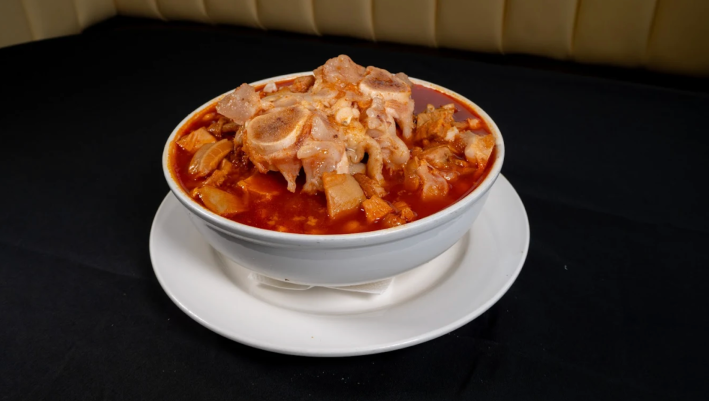
No. 8 Menudo
Mr. Menudo ~ Multiple Locations
The rising star in the menudo game, Mr. Menudo, has made a name for themselves from slanging bowls on East Compton’s taco row to having multiple locations in Downey, Bellflower and soon West Covina. The marked difference with this menudo is that it is much cleaner-tasting than most bowls. You won’t see layers of collagen and fat rendered on the top of the bowl. You can order it with or without hominy, but truthfully, any bowl of menudo tastes best without.
The beef pansa they use in their menudo is springy but not overly chewy, which tends to soak up the caldo. The broth has a hint of chiles, but not overly so. If you’re looking for the heat, they offer peppery powdered chiltepin from Sinaloa. It works wonders on anything it touches and tripe is no exception.
Need more menudo options? Check out our complete guide.
16203 Clark Ave E. Bellflower, CA 90706
Make it at home: Recipe Video

No. 7 Pozole
Pozolería Doña Ana ~ Panorama City
My indigenous ancestors used to think humans were made of masa (around Christmas time, they’re not wrong) and that hominy was therefore magical. The ceremonial origins of OG pozole, made of nixtamalized corn and chunks of human flesh, don't help this pre-Hispanic belief. You don’t have to imagine how much seasoning and spices would be required to mask the stench of a dead person or what that would even taste like because some conquistador foo, who wrote about the transition from human pozole to pork pozole, said pork tasted awfully close. All these Mexican caldo folk tales aside, pozole is still powerfully restorative and it beats menudo for its meat vs. offal-based broth. The former being more approachable for many.
Pozolería Doña Ana, in Panorama City and Pacoima, is a Los Angeles gem. The family behind the restaurant believes that Mexican food provides more than just a meal. They think it offers a celebration of life, and you can taste that. The business makes its famous pozole rojo estilo Nayarit with your pick of pork and chicken.
For a mix of the best, we recommend their loaded pozole rojo, which comes with pork meat, pata (pork foot), and cuerito (pork skin). This is the only dedicated pozolería in Los Angeles County and the best pozole in the San Fernando Valley. Doña Ana started selling pozole in the streets to help her with her mental health and now she's developed a huge following for her pozoles. We definitely recommend pairing her pozole with her tacos dorados de picadillo for the complete pozole-induced euphoria effect.
For more pozole spots, check out our full guide.
14551 Nordhoff St. Panorama City, CA 91402
Make it at home: Recipe Video
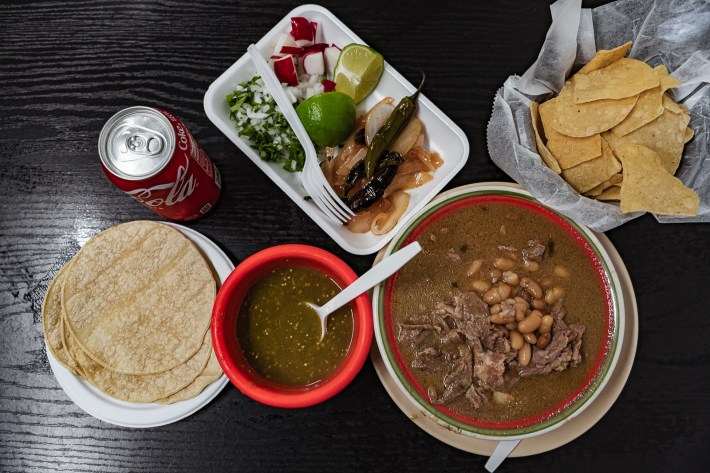
No. 6 Carne en Su Jugo
Taquería Millo ~ Inglewood
Carne en su jugo is a specialty of Jalisco. The ingredients can vary, and so can the way it’s prepared. Some chefs like to cook everything together in one pot, while others will cook ingredients individually and serve them together in a bowl. It’s fantastic either way because blended tomatillos and beef broth go together like pho and sriracha sauce. It’s hard to go wrong when you slow cook a broth of beans and beef filets, and top it all with crispy bacon bits to excess on its delicious excessiveness.
There’s a 40-year-old tradition that happens every Monday morning, and only on Mondays, in the unincorporated town of Lennox. Taquería Millo prepares a large steaming pot of listo-pa’-la-chinga carne en su jugo to get their customer base of primarily gardeners and construction workers' bellies ready to kickstart the week strong.
You have to get there early to snag a bowl filled with generous cuts of stewed beef, beans, and topped with crispy bacon before they sell out around noon. Add their caramelized onions to the bowl for that added roasted sweetness and pair it with one of their signature “Millo-cheladas” to help wash away any lingering feelings of the weekend behind you (go next door to buy your beer of choice).
The original recipe belongs to the now-deceased founder, Emilio “Millo” Becerra, of Tepatitlán, Jalisco. Still, his children and family keep the tradition going strong, including having a different specialty item each day of the week. For more carne en su jugo places check out our vetted "eat like chente" guide here.
11040 S Inglewood Ave. Inglewood, CA 90304
Make it at home: Recipe Video
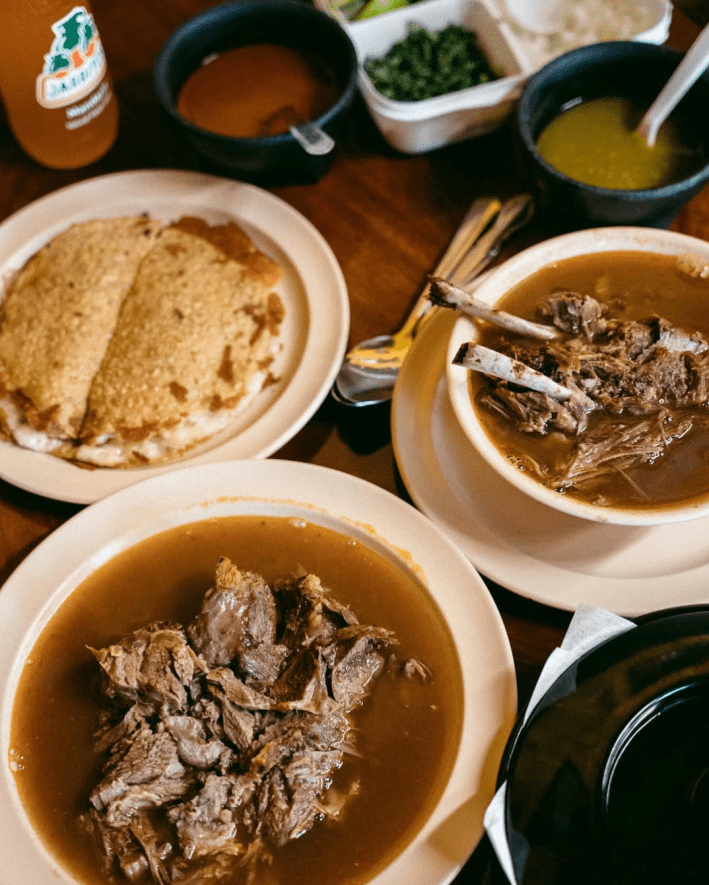
No. 5 Birria
Birrieria Nochistlan ~ Boyle Heights
If you stay eating tacos in Los Angeles, you might think birria is just a guiso or protein that stuffs a quesataco. Birria tacos have become so popular that even OG taco trucks are pivoting to the red taco craze and stuffing it in cemita buns. But birria is actually a bad MF when slow-cooked and qualifies as a type of caldo to some, with its broth made of of chile de arból and chunks of beef, goat, or lamb. Just as often here and much more often in Jalisco, it can be an entire goat—roasted bones and all. There really is no reason birria shouldn’t be No. 1 on this list. I mean it’s just a bowl of meat, broth, onions, chile, and cilantro. But also, it’s just a bowl of meat, broth, onions, chile, and cilantro. And you can get a good bowl made with chivo at the classic Birrieria Nochistlan in Boyle Heights.
3200 E. 4th St. Los Angeles,CA. 90063
Make it at home: Recipe Video
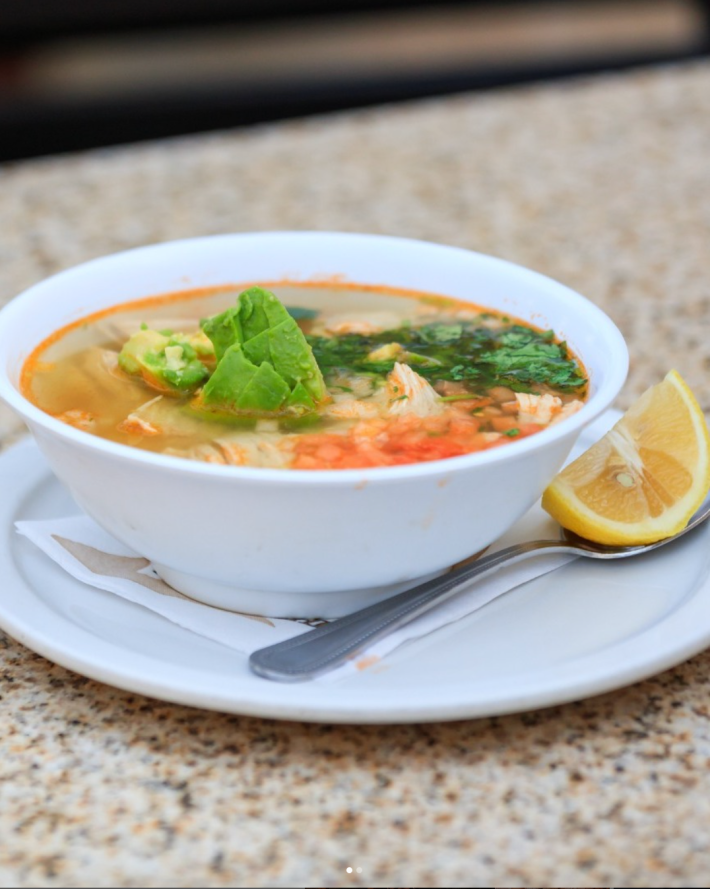
No. 4 Caldo de Pollo
Avila's El Ranchito ~ Huntington Park
Now we are entering the part of the list that’s so difficult to rank. It was already hard, man. These are all amazing dishes and picking one over the other has my stomach in tears … or maybe I’m just hungry. But caldo de pollo is so perfect. Chicken was meant to be eaten in a broth. Fried, yes, please. Rotisserie, for sure. Grilled, I guess. But slow-cooked in a broth of a rainbow of the finest vegetables and splashed with lime and hot sauce and eaten with tacos de queso fresco just hits differently, especially when prepared by a loved one and a talk show on Univision is on at full blast somewhere in the room. And here in Los Angeles, many places serve a good and hefty serving, one of them being Avila's El Ranchito.
6703 Santa Fe Ave. Huntington Park, CA 90255
Make it at home: Recipe Video
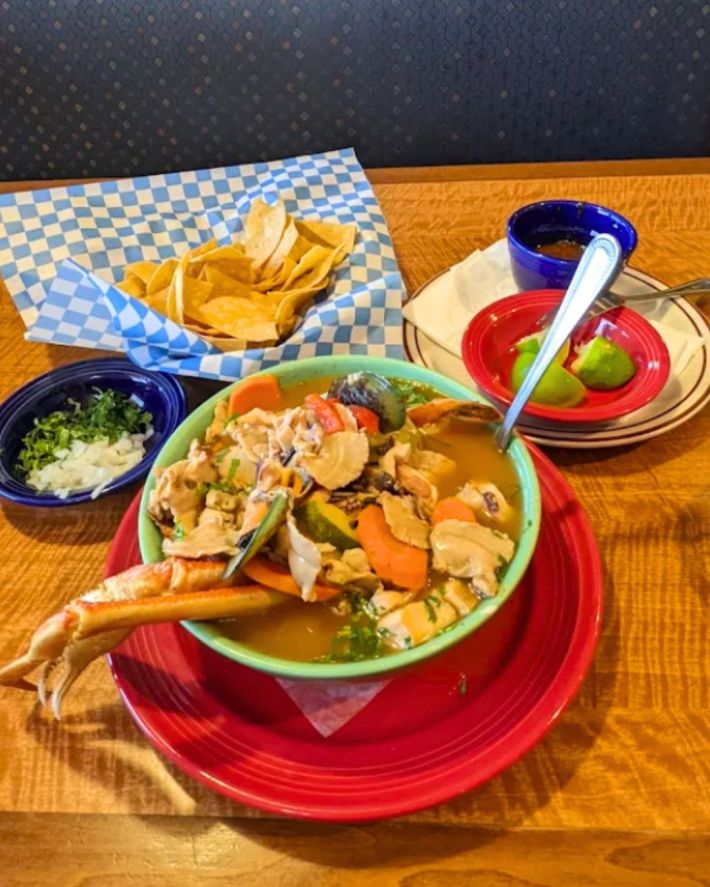
No. 3 Siete Mares
El 7 Mares ~ Boyle Heights
In the late 80s, my father chased this melody of mariscos all over Los Angeles, trying I assume to treat his hangover. Good mariscos in L.A. is as synonymous as good tacos. My father grew up in Sinaloa, where mariscos rival cartel bosses in notoriety. Un caldo siete mares combines all his favorite creatures from the seven seas into one brilliant broth. A good one was incredibly hard to find back then. It’s a hard trick to pull off, considering even a simple fish caldo can turn too fishy quickly. Siete Mares offers a variety of seafood, including white fish, shrimp, octopus, squid, mussels, crabs, and clams. All that plus potatoes, carrots, and a bunch of other flavors. With a nearby jukebox on at full blast bumping Grupo Codiciado's 'Gente de Accionar,' discovering the meaning of life is just a slurp and tortilla-bite away.
2747 E Cesar E Chavez Ave. Los Angeles, CA 90033
Make it at home: Recipe Video
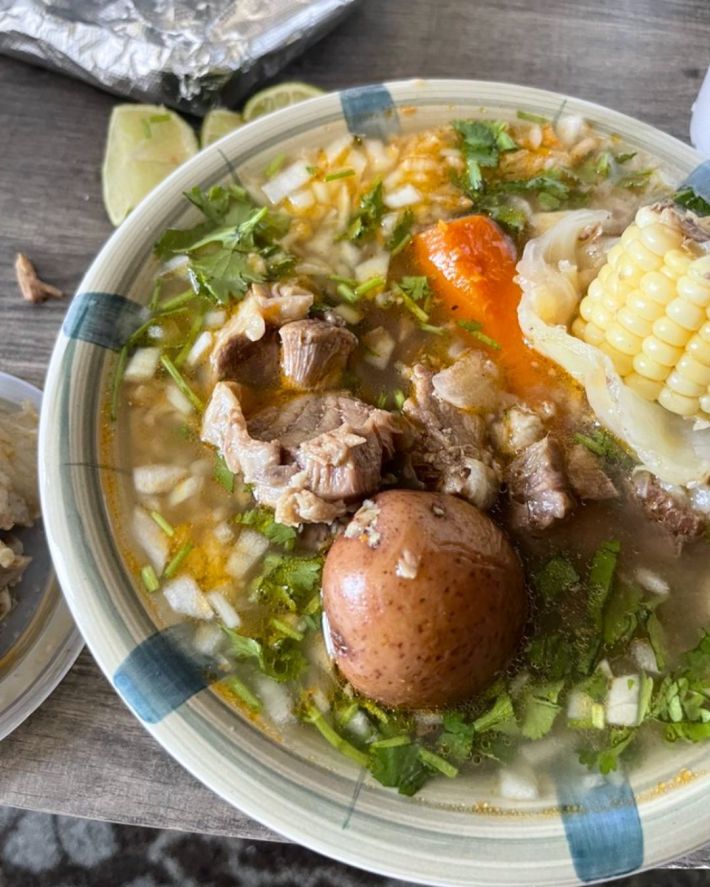
No. 2 Cocido/Caldo de Res
Santa Cecilia ~ Boyle Heights
In my house, we call caldo de res 'cocido.' I don’t know why. It must be a regional thing. I really don’t care what it’s called, I could have this meal every day for the rest of my life and not grow tired of it. It’s bone-in beef shank cooked in broth for up to three hours until all the meat, even the bone marrow, is melting off the bone. A large pot of this caldo will usually feed my whole family for days with each ensuing day delivering an increasingly better bowl of cocido.
Like carne en su jugo, this is one those dishes where the individual ingredients are usually transformed, the vegetables are usually roasted for example, before being added into the broth to finish cooking. It can take all afternoon to make, but the effort usually results in one of the best dishes on the planet. A little chile or salsa goes a long way in cutting the richness, so double up for double satisfaction. At la Santa Cecilia you will find a caldo that tastes like home.
Mariachi Plz De Los, 1707 Pleasant Ave. Los Angeles, CA
Make it at home: Recipe Video

No. 1 Frijoles de la Olla
The best dish on the planet is so simple and ancient, Americans would probably elect it president if it weren’t so Brown. I will take a bowl of frijoles de la olla with diced onions, queso fresco, and chile verde over just about anything. Now you may be thinking, that’s not a caldo, foo. But you’d be wrong.
In fact, way back in the day, caldos used to be called ollas because they were made in clay pots. Even the word caldo just means hot broth. Beans are the original hot broth. And if you want to add a bunch of other ingredients into the pot, go ahead. May I suggest some crumbled queso fresco and pico de gallo? But the simplicity of frijoles de la olla is what makes them perfect and quite possibly the most eaten Mexican dish in the world. It may have been the first fully-formed Mexican dish in the world. I don’t know, I’m not a food historian. I’m just a red-headed Mexican American who loves beans like a cartoon billionaire duck loves swimming in gold and bragging about his Number One Dime. Woo-oo!
The best part is that you don't have to leave your house; you can make these at home. Recipe Video.

Janette Villafana contributed to this report.







